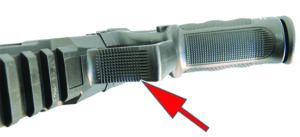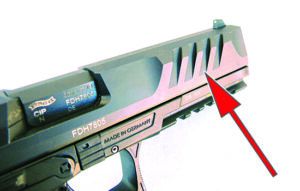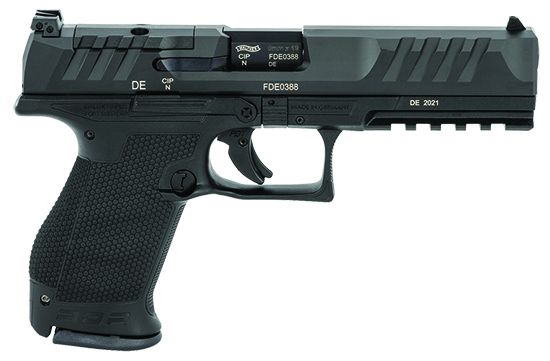Polymer-frame striker-fired handguns are flexible in design and performance, so it is simple enough to design a pistol with different-length slides and frames. In the past, full-size service guns were usually downsized by shortening the slide, and often the slide and the frame, creating a compact pistol. Among the most famous compact designs is the Glock 19 9mm, shrunk in size from the Glock 17. Later, Glock introduced the Glock 19X and the similar Glock 45 9mm. These pistols feature a Glock 19 compact slide and full-size Glock 17 frame. The pistol is fast from leather and features a full-length magazine. Some were skeptical, but the 19X pistol has been proven in hard use.
In this test, we have other variations, a long-slide short-polymer-frame design and a short-frame standard-slide combination. The Walther PDP Compact, or PDPC for short, is a compact-frame pistol with a 5-inch barrel and slide. The Glock 49 9mm is a Glock 19 compact frame with a Glock 17 service-pistol slide. These new pistols may be a good fit for many shooters with average to small hands in particular, including concealed-carry handgunners, practical competition shooters, and home defenders. Does the service-pistol slide and compact-frame-grip-type pistol pan out in action? And if so, which of the two, the Walther PDP Compact or the Glock 49, is the better choice? Our testers get to the bottom of the question.
Walther PDP Compact 5-Inch 2844222 9mm Luger
$570
Gun Tests grade: A (BEST BUY)
The Walther’s accuracy is good, and the pistol’s grip texture and SuperTerrain cocking serrations are appreciated. Reliable. We liked the Walther’s accuracy advantage off the bench.
| Action Type | Semi auto, short recoil operated, two-piece striker fired, +P rated |
| Overall Length | 8.0 in. |
| Overall Height | 5.5 in. |
| Maximum Width | 1.3 in. |
| Weight Unloaded | 26.0 oz. |
| Weight Loaded | 34.0 oz. |
| Barrel | 5.0 in. long, 1:10 twist |
| Slide | Black steel |
| Slide Retraction Effort | 15.0 lbs. |
| Frame | Black polymer |
| Frame Front Strap Height | 2.5 in. |
| Frame Back Strap Height | 3.5 in. |
| Grips | 3 modular back straps |
| Grip Thickness Maximum | 1.3 in. |
| Grip Circumference Maximum | 5.2 in. |
| Front Sight | Post, white dot |
| Rear Sight | Two white dots, adjustable |
| Trigger Pull Weight | 5.0 lbs. |
| Trigger Span | 2.75 in. |
| Magazines | (3) 15 round |
| Safeties | Firing-pin block, trigger lever |
| Warranty | Limited lifetime |
| Telephone | (479) 242-8500 |
| Website | WaltherArms.com |
| Made In | Germany |
We found the 5-inch-barrel Walther runs a narrow price deviation across the board, with less than 2% deviation and averaging $30 more than the standard PDP 9mm. The PDPC 5-inch barrel is a compact grip frame married to a 5-inch slide and barrel. The PDP is a popular handgun that builds on the success of the PPQ 9mm. It is another polymer-frame striker-fired handgun that may be said to feature the big R – Reliability — and little M — maintenance. The Walther pistol is supplied with three magazines, a magazine loader, optics plates, a gun lock, and a manual. The Glock 49 mirrors those accessories.
The PDP grip is designed for maximum ergonomics. The slide and frame offer good interface with the shooter. A rater with a great deal of police security and training experience noted that you do not see many Walther handguns in police and military service because they will never be a low-bid firearm. There is much truth in that statement. The Walther is designed to provide superior handling, ergonomics, and accuracy compared to most other guns. Other handguns get the job done, while Walther aspires to do so with more class. That is fair enough, and we wished to see if this assumption held true against Glock’s newest pistol, also a short-frame handgun with a long slide. When we talk polymer, the elephant in the room is always a Glock.

Walther PDP pistols are offered in different frame sizes, with the Compact frame accepting a 15-round magazine or longer magazines with the magazine body exposed. The larger standard frame offers an 18-round magazine capacity. Barrel lengths of the Compact are 4 or 5 inches, and the Pro SD Compact with a threaded muzzle coming in a 4.6-inch tube. All of the pistols use identical controls. The magazine release, slide lock, takedown levers, and trigger action are identical across the board, and ours operated in a positive manner. Walther wisely chose a Glock footprint for their sights. As a result, the sights are nothing special, simple white-outline plastic sights, practically identical to the Glock 49, save the Walther features an adjustable rear sight, a big plus. Also, the Walther accepts Glock aftermarket sights. We fired the pistols with their issue sights.
The pistol features a polymer frame, steel slide, and striker-fired mechanism. A frame rail accepts combat lights or lasers. Walther calls the new-design cocking serrations SuperTerrain. We find these cocking serrations are easily grasped and offer plenty of leverage. On that count, the Walther is superior to the Glock. These 1⁄8-inch-deep serrations slope slightly compared to the Glock serrations. If you mount a red-dot sight, forward cocking serrations will be more important.

The grip frame size is compact, not sub-compact, size and offers good hand fit for most hands. The pebbling and texture of the Walther grip frame offers a good mix of abrasion and adhesion. It is different than the Glock, not certain it is superior, but it is more involved. Front-strap checkering runs at 25 lines per inch. In common with the Glock, the Walther features a trigger with a safety lever set into the trigger face. There is an internal striker block for drop safety. The trigger of the Walther is often pointed out as superior to the Glock. The Walther trigger feels much the same as the Glock in operation. A trigger press, meeting a wall, the trigger breaks, and you have a rapid reset. The Walther trigger breaks the sear at 5.1 pounds versus 5.6 for the Glock. While the Walther trigger is arguably better, there is not a huge difference.
The Walther’s 5-inch barrel seems to be a snug fit in the slide. The overall fit, finish, and appearance of the Walther is good. Walther’s stepped chamber is featured in the PDP line. A stepped chamber is tighter the deeper the cartridge is seated. We found no demerit in a stepped chamber as far as reliability goes. As far as velocity, the slightly longer Walther PDPC barrel averaged about a 20-fps advantage over the shorter Glock barrel.
We did not explore the red-dot-sight option, but the pistols seem equal in that regard. Red-dot-sight capability is the primary reason the PDP slide is slightly wider than the original Walther PPQ, not a huge difference but wider than either the Glock 49 or Walther PPQ. The balance of the 5-inch-barrel PDP Compact seems to be neutral, with little slide bias. We feel that Walther put most of the weight in the grip frame, while the slide contains less of the total weight.
For the initial combat test firing, we used CCI Blazer 115-grain FMJs and Fiocchi 147-grain JHPs, offering a good test of cycling reliability. In 25-yard accuracy testing, we used three loads for accuracy testing, Federal 147-grain HST and 147-grain Syntechs, which were included in a value pack, and Speer 124-grain Gold Dots. We used a Galco TAC belt slide, large size, for most of the combat range work. This is a simple holster with good pistol fit and speed, and it is affordable.
On the combat range, we concentrated on drawing quickly from concealed carry and addressing targets at 7, 10, and 15 yards. We also incorporated speed loads into the firing tests. The Walther did well, coming on target quickly and offering a combination of decent sights and a very good trigger. We found the pistol to be controllable, and it delivered good combat groups. During speed loads, we found the Walther slide lock to be faster and easier to manipulate than the Glock. The difference was difficult to qualify, but it existed. There was no difference in the sights between the two pistols; each was equally effective. During the combat drills, we fired 50 cartridges of each type. Firing the pistols one after another, we noticed a difference in recoil impulse and recoil control and recovery. It was noticeable to all raters. Recoil was not uncomfortable with either handgun. However, we noted the Glock seemed to recoil less and offered faster recovery. While the Glock trigger is heavier, the Glock reset is at least as rapid as the Walther. In the end, with both loads and all raters, the Glock provided slightly better combat groups. This was unexpected but qualified. We decided to run another 50 rounds through the test guns, splitting a Blazer box between the two. No question the Glock was the easier-shooting pistol, in our view.
Firing for bench accuracy, we put the pistol in an MTM Case-Gard pistol rest and settled onto the bench at the 25-yard line. We used three loads in accuracy testing: Federal 147-grain HST, CCI Blazer 115-grain FMJ, and Hornady American Gunner +P 124-grain XTP. All loads were accurate, and none exhibited excess recoil. The Walther edged the Glock 49 out in bench accuracy. One group we fired was just under 2 inches, which we consider excellent for nearly any pistol.
Our Team Said: The Walther is a reliable, accurate, and reliable pistol. A mix of bullet weights and standard and +P loads proved reliable. The pistol has more recoil than the Glock 49. The Glock is more compact, yet kicks noticeably less. The Walther is the more accurate in slow fire. If you are a competition shooter, the difference in recoil control may direct you to the Glock, while the difference in accuracy may make the Walther a better choice. Then there is the Walther’s speed-loading advantage. Reliability is a given with both guns, and we don’t say that lightly, but these are reliable handguns with a wide range of loads. Size and weight do not matter in practical competition or home defense. We like the Walther’s takedown and trigger.
Aftermarket sights for the PDP Compact are no problem, with the Walther accepting Glock-compatible sights. Red-dot sight and combat light mounting are similar with each handgun. The bottom line among two similar handguns is price, and the Walther’s average price is less than the Glock’s average. The Walther PDP Compact is the better buy in this match-up.
| 9mm Luger Range Data | ||
| Federal Premium 147-grain HST JHP | Walther PDP Compact | Glock 49 MOS |
| Average Velocity | 1001 fps | 980 fps |
| Muzzle Energy | 327 ft.-lbs. | 313 ft.-lbs. |
| Small Group | 1.8 in. | 2. 0 in. |
| Average Group | 2.4 in. | 2.5 in. |
| Federal Premium 147-grain Syntech TSJ | Walther PDP Compact | Glock 49 MOS |
| Average Velocity | 955 fps | 947 fps |
| Muzzle Energy | 298 ft.-lbs. | 293 ft.-lbs. |
| Smallest Group | 2.0 in. | 2.45 in. |
| Average Group | 2.4 in. | 2.75 in. |
| Speer Gold Dot 124-grain GDHP | Walther PDP Compact | Glock 49 MOS |
| Average Velocity | 1121 fps | 1099 fps |
| Muzzle Energy | 346 ft.-lbs. | 333 ft.-lbs. |
| Smallest Group | 1.7 in. | 2.1 in. |
| Average Group | 2.2 in. | 2.6 in. |
We fired groups at 25 yards from a benchrest position using an MTM Case-Gard K-Zone Shooting Rest. We used a Competition Electronics Pro Chrony to measure muzzle velocities. Notes: JHP = jacketed hollow point. TSJ = Total Synthetic Jacket. GDHP = Gold Dot Hollow Point. HST is not an abbreviation for anything.
Written and photographed by Gun Tests Staff, using evaluations from Gun Tests Team members. GT






























